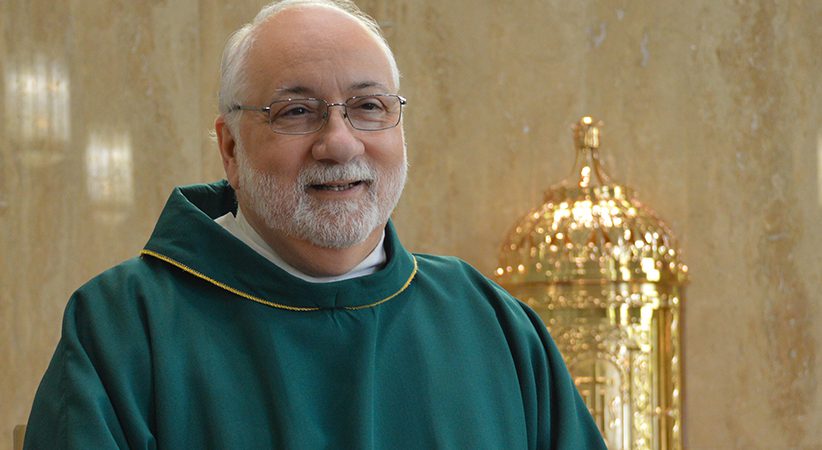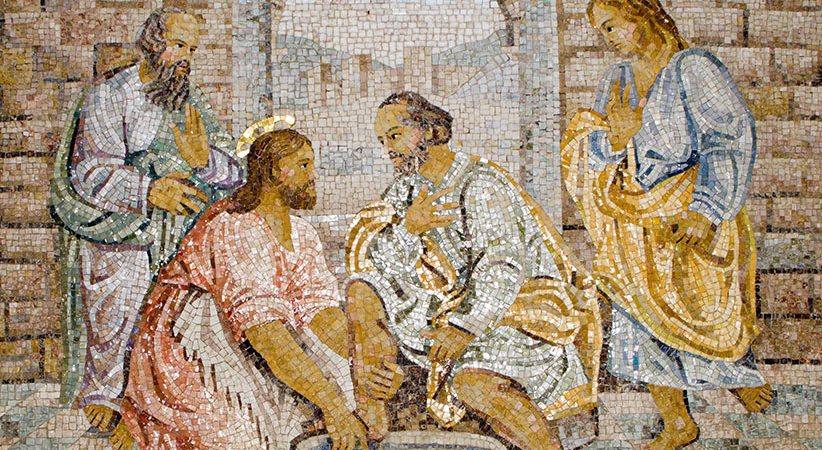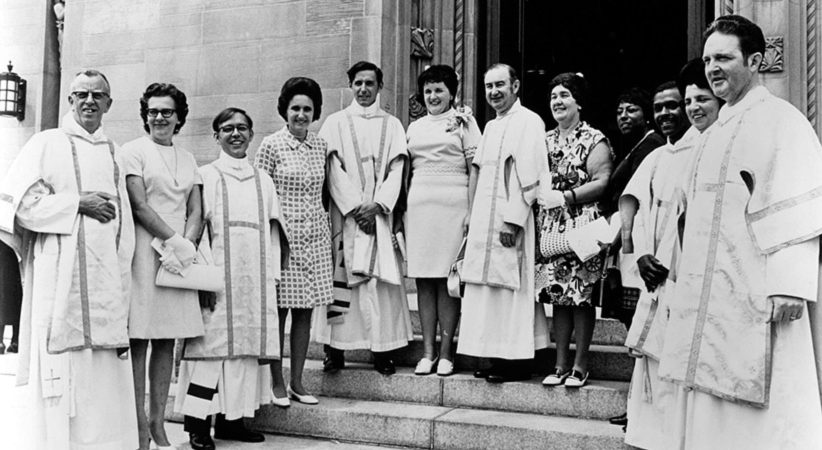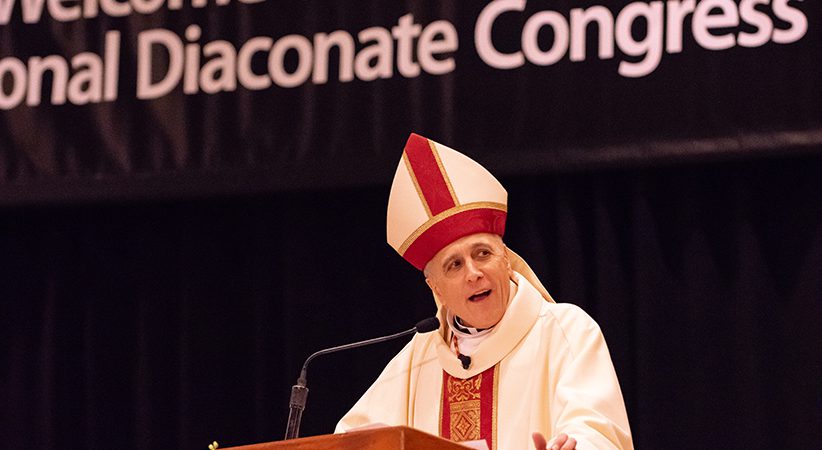Liturgy from the Heart
Exploring the interior and exterior life of Christ and deacons
David W. Fagerberg Comments Off on Liturgy from the Heart
In his apostolic letter Sacrum Diaconatus Ordinem (General Norms for Restoring the Permanent Diaconate), Pope Paul VI says that Christ instituted a variety of ministries in the Church for the nurture and constant increase of the People of God. Then he quotes the Church Father St. Ignatius of Antioch: “The deacons too, who are ministers of the mysteries of Jesus Christ, should please all in every way, for they are not servers of food and drink, but ministers of the Church of God.”
What do deacons serve? Not food and drink, but mysteries. It can seem, sometimes, that we have forgotten Ignatius’s wisdom and reduced the diaconate to an exterior service of food and drink, ignoring its ministry to the interior mysteries. What I ask today is what is required for the deacon’s interior life if he is to serve the mysteries? What is required for him to serve the interior participation by the faithful in the liturgy?
All human beings have an exterior and interior life, and that includes Jesus, since he was a real human being. In his insightful work “Catechism of an Interior Life” (Andesite Press, $23), Jean-Jacques Olier, the founder of the Sulpicians, makes this point, presented in a question-and-answer format.
Q. How many lives are there in Christ?
A. There are two, the interior life and the exterior life.
Q. In what does the interior life of Christ consist?
A. It consists in his interior dispositions and sentiments with regard to everything; for example, in his perfect union with his Father, his love for the neighbor, his humility in regard to himself, his horror for sin, and his condemnation of the world and its maxims.
Q. In what does his exterior life consist?
A. It consists in his outward actions, and in the visible practice of all virtues, emanating from his divine interior.
Q. To be true Christians, then, we must be animated by the Holy Spirit, who makes us live interiorly and exteriorly as Christ did?
A. Yes.
Q. But is not this very difficult?
A. Yes, for him who has not received holy baptism, in which the spirit of Christ is given us, to make us live as he lived.
The Image of God
The starting point for the deacon’s interior life is the same starting point for every Christian’s interior life — namely, baptism. The reason for this, of course, is that baptism begins our conformation to Jesus, as Paul proclaimed in Romans 8:29.
French Jesuit Louis Lallemant says we must become an image of the image of the Father in both his interior and exterior reality, and in both the interior and exterior parts of ourselves. In “The Spiritual Doctrine of Father Louis Lallemant, of the Company of Jesus” (Wentworth, $30.95), he writes: “Jesus Christ is the image of God the Father. We ought to be copies of that image. It is our model. We ought to express in ourselves the features of his resemblance, his virtues, his mind, his interior life, and his exterior life.”
Father Olier also specifies in “Introduction to the Christian Life and Virtues” that becoming Christ’s image involves both interior and exterior conformity. “Just as Our Lord was exteriorly crucified, we are called to be interiorly crucified,” according to Olier. “As he died in exterior reality, we must die interiorly.”
Outside and Inside of Liturgy
If liturgy is the presence of Christ, and if Christ has accomplished salvation by exterior mysteries that are sacramental signs of his interior mysteries, then we would not be surprised to find two things going on in every liturgy: one on the outside, one on the inside. Neither would we be surprised to find Church teachings insisting that Christians participate in both an interior and exterior manner.
I know that sometimes these two are placed in opposition to each other, with progressivists placing more emphasis on exterior symbols and traditionalists placing more emphasis on interior devotion, but magisterial documents discourage such a dichotomy. Lumen Gentium drives this home with its parallel listing of ecclesiological features. On the one hand, the Church is a society structured with hierarchical organs, a visible assembly, and an earthly Church; on the other one hand, she is the mystical body of Christ, a spiritual community, and enriched with heavenly things. Then Lumen Gentium emphatically insists that these are not to be considered as two realities, but rather they “form one complex reality which coalesces from a divine and a human element,” rather like Jesus was one hypostatic union composed of a divine and human nature, and therefore “by no weak analogy, [the Church] is compared to the mystery of the incarnate Word” (No. 8). Since this is the Church the deacon serves, he must attend to both the interior and exterior.
Were this not so — if the deacon served only the exterior — then he could be properly prepared for his ministry with simple vocational training. Send him to an ecclesiastical vo-tech school where he could learn the functions of his craft and trade: how to hold the thurifer, how to calculate the count of Sundays in ordinary time, how to organize the soup kitchens and parish educational programs.
But this is not what makes the Church salvific, says Irish priest and academic Father Edward Leen (1885-1944) in “The Holy Ghost and His Work in Souls (Sheed and Ward, $22): “The Catholic system is not merely a means to right living, much less an ingenious contrivance to help us to evade the unpleasant consequences of wrong living. The Church with its system exists primarily for the communication of grace to the souls of men.” Likewise, the deacon’s own interior life needs growth and strengthening.
This is why Scripture will be so important for him, says Jean Grou in “The Hidden Life of the Soul” (Kessinger Publishing, LLC, $43.95). “Those who would study the interior life, must seek to know what was [in Christ’s] mind,” says Grou. “Holy Scripture reveals much of this to us, as regards his Father, himself, and mankind.”
Scripture reading is not for intellectual study alone, but for spiritual inspiration. St. John Eudes, in “The Priest” (Loreto Publications, $14.95), advises: “Give yourself completely to the Divine Spirit who dictated the Sacred Writings. Pray that he may engrave them on your heart, and make your soul and body living gospels and books in which is inscribed the exterior and interior life of Jesus himself.”
Work of Progress
It does not all happen on ordination day, like sacramental magic. As Capuchin Father John Evangelist of Bois-le-Duc says in “The Kingdom of God in the Soul,” “Progress in the interior life is like to the growing of a tree which grows in size and strength imperceptibly; and the tree which takes the longer time to grow remains green for a longer time than the tree which grows more quickly.”.
The deacon is given his marching orders at his ordination, not his retirement papers, and Grou says in “The Hidden Life of the Soul”: “The whole spirit of the interior life is summed up in the words ‘God Only.’ The first step therein is devotion of self to him — all progress in it is detachment from whatever is not him, and its end is perfect union with him.”
Persons are twofold: they have an exterior and interior. Liturgy is twofold: it happens in visible sacramental form and invisible internal form. Therefore, the deacon’s ministry is twofold: it serves the world outside and the inner spiritual needs of Christians.
Lallemant says we should be imitating Jesus, who has an infinite life within and yet acts externally to himself: “This is our model: in the first place, we ought to have within ourselves and for ourselves a most perfect life by a constant application of our understanding and will to God. Then we shall be able to go out of ourselves for the service of our neighbor without prejudice to our interior life, not giving ourselves up wholly to others, nor applying ourselves to exterior occupations, except by way of diversion, so to say; and thus our principal business will ever be the interior life” (The Interior Life).
…………………………………………………………………………………………………………………………………………….
Laying of Hands
“Although some functions of the deacons, especially in missionary countries, are in fact accustomed to be entrusted to lay men it is nevertheless ‘beneficial that those who perform a truly diaconal ministry be strengthened by the imposition of hands, a tradition going back to the apostles, and be more closely joined to the altar so that they may more effectively carry out their ministry through the sacramental grace of the diaconate.’ Certainly in this way the special nature of this order will be shown most clearly. It is not to be considered as a mere step towards the priesthood, but it is so adorned with its own indelible character and its own special grace so that those who are called to it ‘can permanently serve the mysteries of Christ and the Church.’”
— Sacrum Diaconatus Ordinem, Introduction
………………………………………………………………………………………………………………………………………………
The deacon must imitate God in also going out of himself, without giving himself up, without prejudice to his interior life. He is the union of Mary and Martha. “Action must be succeeded by contemplation and contemplation by action, for there is no doubt that the interior life cannot long maintain its vigor unless its exercise be interrupted by exterior employment,” suggests Grou in “The Interior of Jesus and Mary.”
The deacon can neither maintain his ministry without a robust interior life, nor will his interior life maintain its vigor without commitment to exterior diakonia. The active life and the contemplative life are not having a spat that the deacon must subdue; they are meant to act with complementarity.
Francis Libermann, in “Jesus through Jewish Eyes,” describes the harmony of interior-exterior action in his commentary on the Gospel of John: “Since human beings are composed of body and soul, there is necessarily in our works something coming from both body and soul; there are material or sensible aspects to our activity as well as spiritual. Interior faith is the soul of any work and gives it eternal life. The external work is the body so to speak. Without interior faith it is like a body without a soul.” The deacon’s ministry comes forth from his composed body and soul.
There is happiness to be found here. It comes from within: “Never shall we have peace until we are interior men and united with God. Repose of mind, joy, solid contentment, are found only in the interior world, in the kingdom of God which we possess within ourselves. The more deeply we enter therein, the more happy shall we be,” says Lallemant.
Then happiness finds perfection in expression, by going to the place where Jesus found his happiness — namely, in doing his Father’s will.
Again quoting “The Hidden Life of the Soul,” Grou says: “The Cross is the perfection of all interior life. There we see Christ both Priest and Victim, voluntarily offering himself to the glory and justice of his Father, and … all who seek the interior life must be fashioned according to it, and when the discipline seems more than they can bear, let them look upon the Cross, and take fresh courage.”
Offering ourselves to the glory and justice of God is our liturgical activity. We do it sacramentally, exteriorly, corporately in the public liturgy; and we do it spiritually, interiorly, devotedly in our interior liturgy. The deacon straddles both lanes.
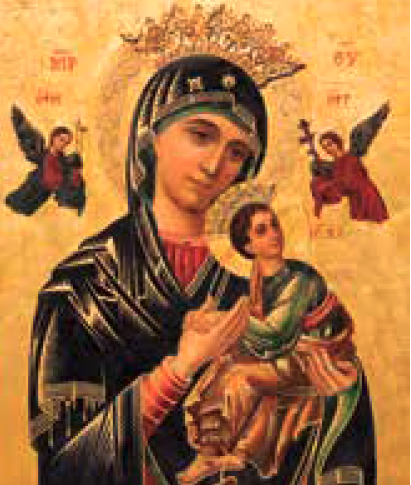
Mary Our Helper
Mary is our helper and pattern. The Vatican Directory for the Ministry and Life of Permanent Deacons describes her as looking with deep veneration and affection on every deacon; she has lived the full truth of vocation; and her love will cause deacons to imitate her life. This is possible because she shares a hidden life with her son, says Pierre de Bérulle, a 17th-century French priest and cardinal: “Happily, she leaves behind her own thoughts and her interior spiritual life to enter into the thoughts of Jesus, into the interior life of Jesus. She enters the love and adoration Jesus offers his Father. She enters the obligations and actions of Jesus” (“The Life of Jesus”).
She has entered the liturgical school of adoration and self-sacrifice, which Grou says is the essence of the true interior life. Her life is a model for the deacon’s life in being filled with “lowliness, absence of self-esteem, love of an obscure life, silence, solitude, diligence in giving heed to little things, faithfulness to grace, to prayer and recollection, total submission to God’s will, complete self-sacrifice” (“The Hidden Life of the Soul”).
The Christian is not distinguished from ordinary men by anything outside, but he is very different within. And when I apply the thought to the deacon, as a man of the Church, I am reminded of James Keating’s definition of the deacon being “a cleric who leads a lay life.” His ministry is camouflaged; he has become a hidden man, not different from ordinary men, but his interior holiness must shine through. So the importance of the deacon’s interior life.
DAVID W. FAGERBERG is professor of liturgical theology at the University of Notre Dame.


